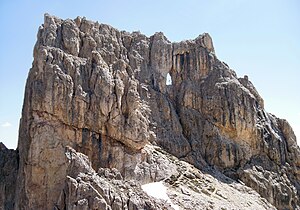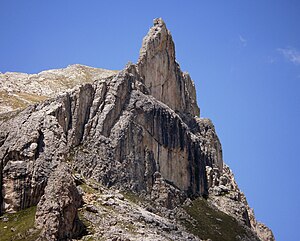Window tower
| Window Tower - Torre Finestra | ||
|---|---|---|
|
The window tower from the west |
||
| height | 2670 m slm | |
| location | Vigo di Fassa , Trentino | |
| Mountains | Rosengarten Group , Dolomites | |
| Coordinates | 46 ° 25 '22 " N , 11 ° 37' 24" E | |
|
|
||
| rock | Sciliar dolomite | |
| First ascent | 1895 Theodor Christomannos , Ernst Platz , W. Dejori | |
| Normal way | West wall ( II ) | |
|
View of the east wall of the window tower |
||
The Fensterlturm ( Italian Torre Finestra , Ladin Croz di San Giuliana ) is a 2670 m slm high mountain in the Rosengarten group in the Italian Dolomites . Its name is derived from a prominent rock window in the middle of the mountain. The Fensterlturm is a popular climbing mountain .
Location and surroundings
The window tower is located in the southern Rosengarten, southeast of the Rotwand (Roda di Vaèl, 2806 m ), above Vigo di Fassa in Trentino. In the southwest lies the 2727 m high Teufelswand ( Roda del Diavolo ), to the east the window tower with its considerably higher walls slopes down towards the Fassatal . Northwest is a small rock prongs called Dente del Croz behind which the Edwards tower ( Torre Edwards , 2625 m ) follows. To the southeast is the Rifugio Roda di Vaèl at 2280 m , and just below at 2273 m is the Baita M. Pederiva . In addition to Vigo di Fassa, these refuges can also be reached from the Karer Pass in the south-west . Access to the Fensterlturm is via the via ferrata on the Rotwand, which passes west of the mountain.
The mountain itself is formed by a narrow rock ridge with the highest point in the south. The window tower has no summit cross , instead a cross was erected in the rock window between the west and east walls. This cross gave the mountain its Ladin name Croz di San Giuliana ( Cross of St. Juliana ), which is derived from the pilgrimage church of St. Juliana above Vigo di Fassa.
Routes
The window tower was first climbed on August 27, 1895 by the alpine painter Ernst Platz together with the South Tyrolean tourism pioneer Theodor Christomannos and W. Dejori . According to other sources, Platz climbed the mountain alone. The first to climb chose today's normal route , which is also one of the shortest climbs (only about 30 meters in altitude) and leads over the west face in difficulty level II (UIAA) to the narrow summit ridge. Another route on this page is the Direct West Face (V). The south and east facing routes such as the south ridge (IV), the east wall (VI +, variant VII), Schräger Riss (V +) or the north-east wall (V +) are significantly longer with up to 110 meters in altitude.
literature
- Heinz Mariacher : Alpine Club Guide Dolomites Rosengarten Group . Ed .: German Alpine Association , Austrian Alpine Association , Alpine Association South Tyrol . Rother, Munich 1988, ISBN 3-7633-1250-1 , p. 92-98 .


